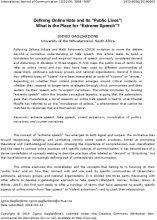Following Sahana Udupa and Matti Pohjonen’s (2019) invitation to move the debate beyond a normative understanding of hate speech, this article seeks to build a foundation for conceptual and empirical inquiry of speech commonly considered deviant and disturbing. It develops in three stages. It first maps the public lives of terms that refer to online vitriol and how they have been used by different communities of researchers, politicians, advocacy groups, and national organizations. Second, it shows how different types of “haters” have been interpreted as parts of “swarms” or “armies,” depending on whether their violent potential emerges around critical incidents or whether they respond to longer-term strategies through which communities and their leaders tie their speech acts to explicit narratives. The article concludes by locating “extreme speech” within this broader conceptual tapestry, arguing that the paternalistic the gaze that characterizes a lot of research on online hate speech is tied to what Chantal Mouffe has referred to as the “moralization of politics,” a phenomenon that cannot be matched by responses that are themselves moral.
